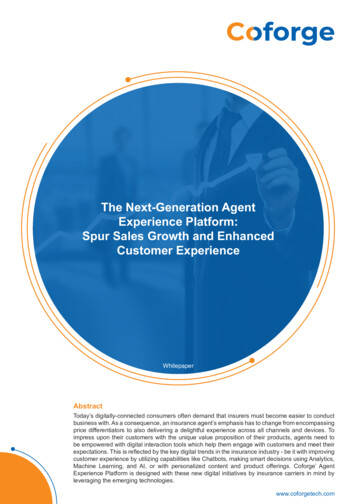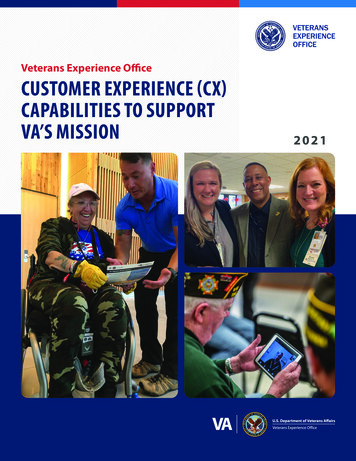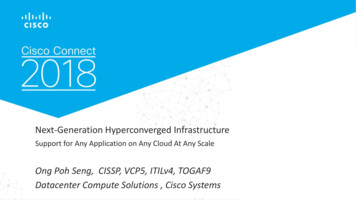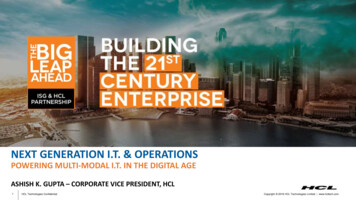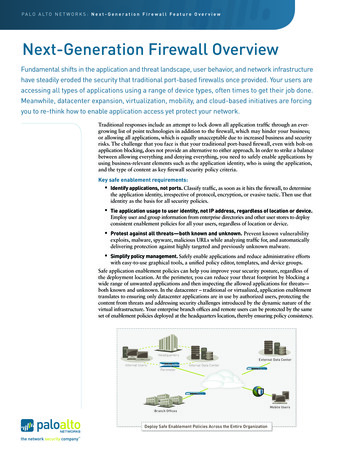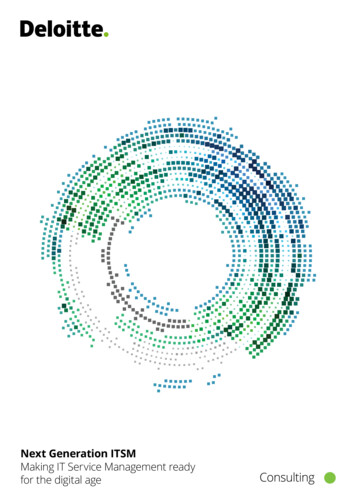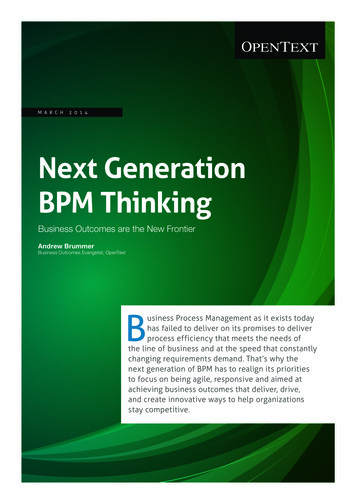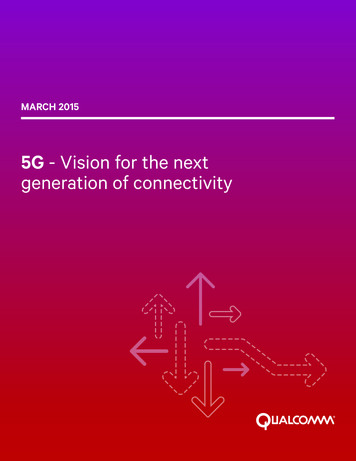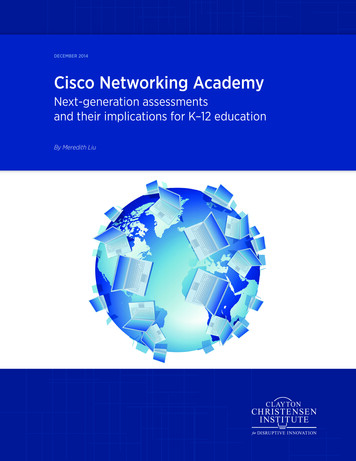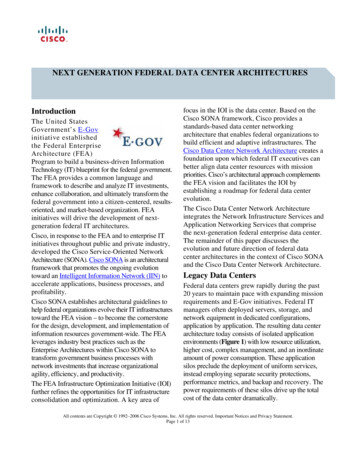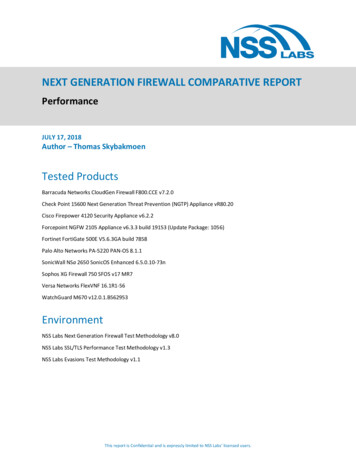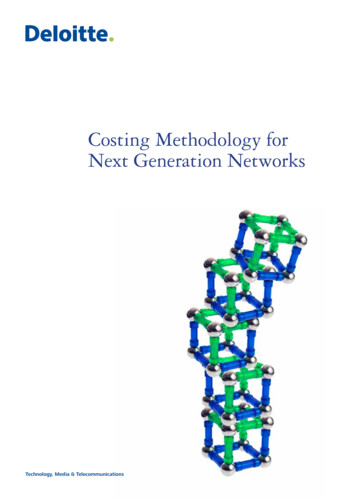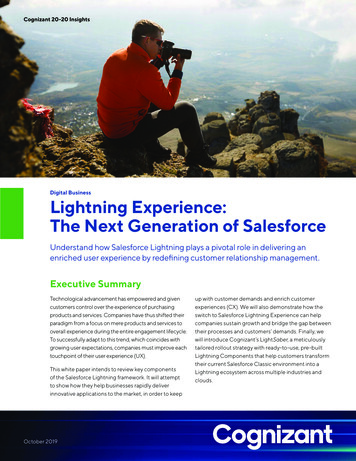
Transcription
Cognizant 20-20 InsightsDigital BusinessLightning Experience:The Next Generation of SalesforceUnderstand how Salesforce Lightning plays a pivotal role in delivering anenriched user experience by redefining customer relationship management.Executive SummaryTechnological advancement has empowered and givencustomers control over the experience of purchasingproducts and services. Companies have thus shifted theirparadigm from a focus on mere products and services tooverall experience during the entire engagement lifecycle.To successfully adapt to this trend, which coincides withgrowing user expectations, companies must improve eachtouchpoint of their user experience (UX).This white paper intends to review key componentsof the Salesforce Lightning framework. It will attemptto show how they help businesses rapidly deliverinnovative applications to the market, in order to keepOctober 2019up with customer demands and enrich customerexperiences (CX). We will also demonstrate how theswitch to Salesforce Lightning Experience can helpcompanies sustain growth and bridge the gap betweentheir processes and customers’ demands. Finally, wewill introduce Cognizant’s LightSaber, a meticulouslytailored rollout strategy with ready-to-use, pre-builtLightning Components that help customers transformtheir current Salesforce Classic environment into aLightning ecosystem across multiple industries andclouds.
Cognizant 20-20 InsightsHow an organization delivers is becomingjust as important as what it delivers.CRM UX CX: The ultimate customer experienceCustomers don’t just seekproducts or services in andof themselves; they alsodemand more convenientprocesses throughout theentire engagement lifecycle.With exponential growthacross industries, it is vital fororganizations to live up to thesedemands and offer customers theultimate experience.According to Walker’s “Customers 2020: AProgress Report,” customer experience will soonovertake price and product as the key influenceon customers’ purchasing decisions, and 86%of buyers will be willing to pay more for a better1customer experience .This is in line with Gartner’s prediction that by 2022,two-thirds of all customer experience projects2will make use of IT, up from 50% in 2017. How anorganization delivers is becoming just as importantas what it delivers.These stats indicate that an organization’s customerrelationship management (CRM) softwareshould provide a richer, faster and more efficientuser experience, and help bring new, innovativeapplications to the market for a greater competitiveadvantage (see Figure 1).Business strategyHow important are the following to your business strategy today and in 2020?Average out of 100 erienceProducts2020Figure 1Source: www.walkerinfo.com/customers2020/2/Lightning Experience: The Next Generation of SalesforcePrice
Cognizant 20-20 InsightsSalesforce Lightning: A user interface optimizedfor speed and increased productivityAlthough the Salesforce Classic user interfaceoffers a plethora of sufficient CRM features, endusers still want fewer clicks and a more user-centricdesign approach that includes features such asdrag and drop. To cater to this imminent need,Salesforce has introduced Lightning Experience:the next generation of Salesforce user interfaceoptimized for speed and increased productivity.With “mobile first” becoming a driving philosophybehind deployments, there is a growing demandfor responsive user experiences and singlepage applications. The tools and technologiesprovided by Lightning offer a new and modernuser experience for both desktop and mobileapplications. Figure 2 highlights the valueproposition and benefits of Salesforce Lightning.Value proposition and benefits of Salesforce LightningSALESFORCE LIGHTNINGVALUE PROPOSITIONBUSINESS BENEFITLightning ExperienceA user-centric designapproach enabling end usersto be more productive at everypoint in the engagementlifecycle.Smoother adoption andcollaboration.Lightning FrameworkAn event-driven frameworkwith aligned tools allowingpartners and customers tobuild custom components tofacilitate business processes.Enhanced productivity andreduced time-to-market.Lightning EcosystemLightning-ready apps andcomponents available throughAppExchange that can beplugged in directly to meetspecific business needs.Better IT productivity andcost efficiency.Figure 23/Lightning Experience: The Next Generation of Salesforce
Cognizant 20-20 InsightsUnderstanding which features of SalesforceLightning that you can leverage is essential todeciding whether to migrate and, if so, whetherit’s necessary for all users.Migrating from Salesforce Classic toLightning ExperienceUnderstanding which features of SalesforceLightning that you can leverage is essential todeciding whether to migrate and, if so, whetherit’s necessary for all users. End users acrossdifferent departments may have unique needs.For example, a service agent may have completelydifferent requirements than that of a salesrepresentative or a company advisor. Therefore, abest practice is to develop different user personasand prioritize functionalities for each. Figure 3highlights what’s new.Salesforce Classic vs. Salesforce LightningServer-side UIApp-centric modelMVC frameworkPage-centric modelResponsive designComponent-basedSALESFORCE CLASSICClient-side UIframeworkEnhanced workspaCustomizEinstein-ceable navigation mbuildingsmart systSALESFORCE LenuemIGHTNINFigure 34/Lightning Experience: The Next Generation of SalesforceG
Cognizant 20-20 InsightsExploring the building blocks of Salesforce tningComponentsLightningSALESFORCE LIGHTNINGApp rServiceLightningOutEnriching the user experience has always been the focus of Salesforce, and Lightning Experience isno exception. Though Salesforce Classic offers a wide range of features, there was still ample room forenhancing its benefits.Apart from its many out-of-the-box features, Salesforce Lightning supports customizations throughits flexible Lightning Framework, which can be considered the underlying support system for all of theLightning features depicted in Figure 3, (see page 4). The framework has an event-driven architectureand provides a runtime environment, out-of-the-box components, and libraries for building customcomponents that you can use to meet business needs and deliver new applications faster.Lightning Components are like reusable building blocks that make customizations possible by clickinstead of code.Another crucial feature that Salesforce has introduced as part of Lightning Experience isLightning App Builder. Until now, building an app to serve a business process or module has beena cumbersome task that could delay time to market by weeks or even months. The Lightning AppBuilder addresses this pain point with a drag-and-drop, point-and-click tool that expedites appdevelopment by allowing custom components to be leveraged across multiple apps.With Lightning Design System, Salesforce has introduced a new way to design, build and delivercustom, pixel-perfect apps. Design System enables creation of custom apps with a look and feel that isin harmony with Salesforce Lightning, and follows the Salesforce design principles of clarity, efficiency,beauty and consistency. It can be used in conjunction with Lightning Components and Lightning AppBuilder and eliminates the need to add static resources to Lightning Components. It also bundles CSSframeworks, icons, fonts and design tokens.Since data collection often requires connection to external systems, Salesforce Connect offersa framework that enables users to view, search for and modify data stored outside of Salesforce.Data from a wide variety of external systems can be accessed and seamlessly integrated into anySalesforce environment in real time. There is no need to copy data into Salesforce, and data can bepulled from legacy systems with point-and-click simplicity. The Apex Connector Framework alsoallows design and construction of customer adapters to meet the specific needs of your business.For most businesses, security is always a top priority. That’s why Salesforce has introducedLocker Service, which adds an additional layer of security and protects Lightning componentsfrom unidentified access and cyber threats. This robust security architecture isolates Lightningcomponents in their own namespace and only allows access to supported application programminginterfaces (APIs). It constantly monitors components for unauthorized data access and preventscomponents from reading the rendered data of other components without any restriction. LockerService employs more secure JavaScript development practices to better serve the needs ofLightning applications.Many organizations need to share centrally accessible information outside of Salesforce. This is nowpossible thanks to Lightning Out, which allows Lightning Components to be bundled and embeddedon a given web page, thereby affording access to CRM features outside of Salesforce. This givesusers the flexibility to directly access information from a desired webpage without having to log in toSalesforce.Figure 45/Lightning Experience: The Next Generation of Salesforce
Cognizant 20-20 InsightsExploring the building blocks of Salesforce Lightning (continued)LightningSALESFORCE ServicesCommunities also stand to benefit greatly from Lightning Experience. With Lightning Bolt, we can nowleverage prebuilt, personalized and mobile communities in Salesforce. This helps create communitiesthat are in sync with business use cases and offers seamless integration with Salesforce. Lightning Bolthas emerged as the fastest way to develop, package and deliver a community. Communities can becustomized with the Lightning Bolt framework, Lightning Components and Community Builder. As withApp Builder, Community Builder’s drag-and-drop capability facilitates the design and publishing ofcommunities.Lightning Data Services (LDS), the data layer of Lightning, provides access to the data being displayed ona page. It helps identify and eliminate independent calls to servers to perform data operations, and sendssingle, shared data requests that update all relevant page components; this feature makes data moreconsistent. LDS also allows work offline, and syncs data once reconnected.As a key part of the Lightning Experience, Lightning Components can contain a significant amount ofuntested JavaScript. Lightning Testing Services (LTS) is a set of tools and services that enables you todevelop test suites for your Lightning Components using standard JavaScript test frameworks (e.g.,Jasmine is one the popular frameworks that can be used for execution of LTS). Lighting Testing Servicesconsists of two major components: LTS managed package (infrastructure) and LTS command forSalesforce CLI (automates running the test suites).Figure 4Lightning Salesforce Einstein promises businessadvantageThe development and application of artificialintelligence is growing exponentially acrossindustries. Lightning harnesses this trend withSalesforce Einstein – a set of capabilities thathave the potential to remove the guessworkfrom business processes. Some of the latestinnovations of Salesforce Einstein include EinsteinLead Scoring, Einstein Opportunity and AccountInsights, Einstein Journey Insights, EinsteinRecommendations and Einstein Vision. Whenclosely integrated with Lightning Experience,Salesforce Einstein can improve lead scoringand opportunity insights and save time throughits Activity Capture feature. Salesforce Einsteincan be utilized in sales, services, marketing, apps,communities, analytics and commerce.Transitioning to Lightning ExperienceThe transition and rollout strategy for LightningExperience is uniquely tailored to each end user.To decide which rollout strategy works best for you,Cognizant creates primary and secondary userpersonas and stories to understand the goals andneeds of specific end users.Following are two rollout strategies that werecommend:6/ Org-based rollout. This strategy does not relyon user personas and thus delivers a consistentuser experience, along with focused learningprograms for all end users. Persona-based rollout. This strategyconcentrates on a fine-tuned and controlledrollout for each persona identified. It involvesheavy customization to ensure that each usersees the most relevant data.Lightning Experience: The Next Generation of Salesforce
Cognizant 20-20 InsightsCognizant LightSaber: The straightest path to painlessdeploymentNow that we’ve seen how Lightning Experienceenriches user experiences, let’s explore how it canrapidly benefit your business.We recommend transitioning to SalesforceLightning Experience using our meticulouslycrafted LightSaber rollout strategy: the best way toaddress all of your business, technical and changemanagement needs.Stage 1: Gather and analyzeThe objective of this stage is to “visualize” thetransition to Lightning Experience. We performa portfolio analysis, define key success metricsand exhaustively verify its feasibility within yourorganization. Then, we recommend either anorg-based rollout or a persona-based rollout byidentifying which applications are likely to benefitfrom investment in Lightning transition during theLightning enablement process.Stage 2: Plan and understandThe purpose of this stage is to formulate animplementation strategy that covers resourcing,budgeting, change management, compliance,deployment and support.Stage 3: Build and deployThis stage focuses on transitioning your organizationfrom Salesforce Classic by building and deployingLightning Experience and its associated components. Cognizant has a rich repository of prebuiltcomponents and applications that are Lightningready and can be deployed directly according toyour organization’s needs and processes.Stage 4: Adop
The Next Generation of Salesforce Understand how Salesforce Lightning plays a pivotal role in delivering an enriched user experience by redefining customer relationship management. Executive Summary. Technological advancement has empowered and given customers control over the experience of purchasing products and services. Companies have thus shifted their paradigm from a focus on
